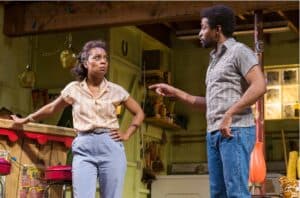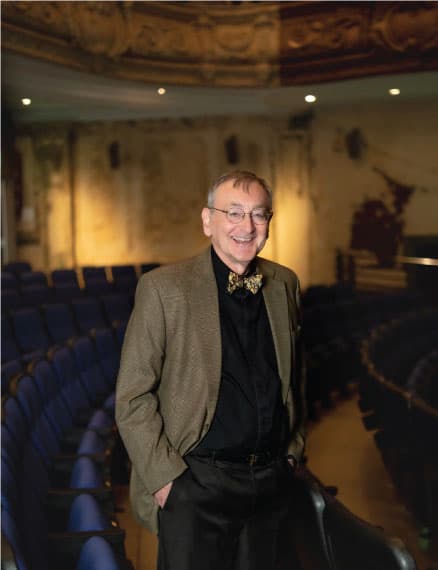DETROIT ’67 a Lot Like Baltimore ’15
Posted on BroadwayWorld.com April 18, 2016
It is doubtless no mere accident of scheduling that Dominique Morisseau‘s 2013 play Detroit ’67 is being presented by Center Stage almost exactly a year after the death of Freddy Gray and the ensuing Baltimore riots. Yes, it is safe to say that the riots that broke out in Detroit in July 1967 were far more deadly and destructive than our April 2015 upheaval, and the long-term impact of July 1967 on Detroit will prove far worse than the impact of 2015’s unrest upon this town. The topicality rests less in the scale and significance of the events, however, than in the explanation for them.
Heaven knows I didn’t have an explanation at the time. I grew up in Ann Arbor, 40 miles outside Detroit, and had just graduated from high school a month before. And to me and my predominantly white compatriots, the bloodshed and destruction in Detroit were inexplicable. Why were the black citizens ruining black neighborhoods? Were they crazy?
Morisseau’s aim in writing Detroit ’67 may not have been to explain this now-ancient history to people like me, but her play certainly tenders an explanation that makes a lot of sense, and which resonates with my understanding of what happened last year a few blocks from where I now live in Baltimore. Not to give too much away, Morisseau’s thesis is that the black citizens of Detroit were not crazy, just reacting to an ongoing culture of police abuse, and that abusive police and military responses were to blame for most of what went wrong once the spark of protest had been struck by the raid of an unlicensed after-hours drinking club known as a “blind pig.”
I have not made a study of the Detroit upheaval, but what little I’ve read suggests that the tale was more complex than Morisseau depicts. No matter. She has latched onto what is at minimum an important piece of the truth, and one we need to have retold at this juncture in our national and local dialogue.
Her play is set in a house not far from Detroit’s 12th Street, the heart of the uprising, a private home being customized, as the action begins, to function as a blind pig. The owners, a sister and brother named Chelle and Lank (Michelle Wilson and Amari Cheatom, pictured above), are trying to get by in a world where setting up a legitimate and licensed bar may be only a dream, too expensive and too difficult, given the capital demands of a bar and the undertow of police harassment. There is nothing sinister about them. (This squared with my recollection: a few years earlier than the action of the play, a black couple who frequented blind pigs lived next door to our house; and they too were just trying to get by.) In prepping the house Chelle and Lank are aided by Chelle’s best friend Bunny (Jessica Frances Dukes) and Lank’s best friend Sly (Brian Marable). Then, as the preparations continue, Lank and Sly find themselves rescuing Caroline (Sarah Nealis) a badly-beaten and comatose white woman in microskirt and go-go boots, who, when she comes to, is obviously hiding some kind of secret and, for that matter, hiding plain and simple. But she too agrees to help out.
In the two weeks or so of these characters’ lives the play covers, it becomes apparent they are all urban strivers, pursuing one dream or another in a bleak world that is inhospitable to dreams. Specifically, every dream turns out to be under threat by lethal police brutality clothed with near-unassailable impunity. And when one routine police atrocity too many, a raid at a competitor blind pig, precipitates a neighborhood explosion of outrage (a sort of race-centric Stonewall) and then a city-defining conflict between citizenry and law enforcement, some of these dreams will prove too costly and must be jettisoned. At least one dream will survive, though, bathed in tears but alive.
There is a lot of sociology at work in the characterizations, which I won’t bother with discussing. It reminds me of the character construction of August Wilson, a vastly overrated playwright whom Morisseau has nonetheless repeatedly claimed to be emulating. For my money, though, based at least on this play, Morisseau is much better at Wilson’s game than Wilson is. LikeLorraine Hansberry, Morisseau gives us types who are also individuals, brimming with life. Bunny is a bit of a sexual free spirit, entering in a skintight patterned outfit with a big cutout in the middle of the bosom, not above engaging in a grinding dance with a male character or reminiscing lasciviously about her first kiss. Lank and Sly are schemers in both the good and the bad sense, pushing their project of a legitimate bar by fair means and foul, engaging in a bit ofRaisin in the Sun-ish skullduggery with an inheritance and taking other risks that more established and white businessmen probably would not have needed to take to further the scheme. They each are given opportunities, nonetheless, to show capacities for love and loyalty and connection. Chelle is tempted to be either a termagant or a pushover for the men in her life and succumbs to neither temptation in the end. And Caroline’s path to integrity is perhaps the hardest any of the characters encounters. The actors portraying each member of the quintet are superb (though I wish Ms. Dukes would speak more clearly).
The set by Michael Carnahan certainly bears comment as well. It goes to great lengths to reconstruct in detail what a Detroit basement and ground floor looked like in 1967, from the furniture to the lamps to the pillows on the couch to the products on display. That period detail pays off in making us believe in what we’re watching. (I detected only one error, and that an error only a Michigander of my vintage would spot: an onstage carton of what was in 1967 strictly a local ginger ale called Vernor’s anachonistically bearing the modern spelling Vernors, sans apostrophe.) The upper level is largely used for projections of videos, mostly from the events of 1967 in Detroit, drawn from who knows what archives. But at the end, after the parallels to modern events have already been clearly implied, the gloves come off, and there are projections of modern police atrocities, including the shooting of Walter Scott and the image of a “Black Lives Matter” sign being waved.
Let me also mention the music, which is a rich potpourri of Motown’s offerings of that era. Every time a character puts on a Motown recording, it is an invitation to love and/or rejoicing. It is also a thematically significant plot point that Chelle wants to play them on 45s, scratch-induced repeats and all, while her technologically forward-thinking brother wants to play the songs on a new eight-track player. But it is perhaps of greatest importance because of Motown’s cultural significance at the time. It was a local Detroit product with a totally African American face (though there were some white men in the company’s backroom business operations); at the same time, unlike “race music” of the then-recent past, Motown’s music was marketed to white audiences as well as black ones. But I can well recall that at that time not all white audiences were comfortable with it. I and my friends weren’t, for instance. It may well not have been until The Big Chill came out in 1983, a movie concerning a bunch of white University of Michigan grads sporting a heavily Motown-centric soundtrack, that our tastes caught up. And we were hardly alone in our tardiness.
I don’t think Morisseau was oblivious to this. The far-from-universal acceptance of this wondrous music, with the instantly recognizable sax-and-tambourine orchestrations, suggests, to those who can remember, another way the isolation of Detroit’s black community worked. I think the Motown songs are meant to signal not only how solid the cultural coherence of black Detroit was but also the fact that that community’s signature product, like its grievances, was unable to attract commensurate attention from the larger, whiter world.
My immediate thought as the cast was taking its bows was just “Wow!” It’s been so exciting to be taken along on Center Stage’s Artistic Director Kwame Kwei-Armah‘s adventurous itineraries in recent years, and this play, by a young, relatively unknown playwright with a fresh perspective and so much to say, is typical. Not everything Kwei-Armah has tried has been a total success, like the regrettable all-female As You Like It, Center Stage’s last outing. Not even this play, which seemed about 10-15 minutes too long, and needed to have its pace picked up a little, could be called a total success. But still, better by far to have swung for the fences. We can forgive a whiff or two along the way.
It is a shame that the Center Stage momentum will be slowed a little by construction. This and the previous show in its 2015-16 season had been performed at the very hospitable quarters of Towson University’s Center for the Arts while the headquarters was being overhauled. But apparently this is where Center Stage goes home and hunkers down. The 2016-17 season (at least as to mainstage productions) will start only in November. I can’t wait.
Meanwhile, it will also be quite interesting to see the reception this production receives at its next stop, the Detroit Public Theatre, which co-produced it, and where it will play next month. (I’m sure there will be more. and better informed comparisons between what Morisseau has put on stage and people’s recollections.) And I hope more of Morisseau’s work gets staged here.
Copyright (c) Jack L. B. Gohn, except for production photo. Photo credit: Richard Anderson.


 I lived in London and Vienna before coming to the United States, and grew up mainly in Ann Arbor. I was writing plays and stories as early as grade school. My undergraduate years at the University of Pennsylvania, where I first reviewed theater, for the college paper, were succeeded by graduate study at the Johns Hopkins University, where I earned a doctorate in English Literature.
I lived in London and Vienna before coming to the United States, and grew up mainly in Ann Arbor. I was writing plays and stories as early as grade school. My undergraduate years at the University of Pennsylvania, where I first reviewed theater, for the college paper, were succeeded by graduate study at the Johns Hopkins University, where I earned a doctorate in English Literature.